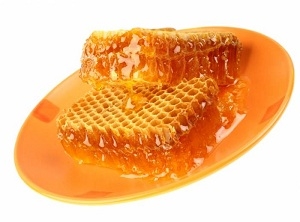Pine honey is produced by honey bees that collect honeydew (‘‘basura’’) from a scale insect species (‘‘Marchalina hellenica’’) which live on some certain pine tree species (‘‘Pinus brutia’’ and ‘‘Pinus pinea’’). Pine tree is produced in two stages:

1. Stage : Tens of thousands of insect species ‘‘Marchaline hellenicas’’ come together climbing on the pine tree to hide in the cracks and under the bark of the pine trees. They form a white bundle of cotton-like wax on the front of the tree which can easily be seen by human being. Those insect species produce honeydew honey from the pine tree extracts in the summer months towards August which dangle from pine trees in lines.
2. Stage : Honeybees carrying honey into the beehives fly in the pine forests carrying pine tree extracts around. Honeybees process these raw extracts with their secretions and carry them into their beehives which then are placed into the honeycombs by the worker bees. The pine tree is produced by the honey bees collecting the honeydew from pine tree, processing it with their own secretions, carrying into the beehives and maturing in the honeycombs by evaporating the water contained in the mixture.

Pine honey is produced in the towns of Mugla-Marmaris-Aydin-Kusadasi and close surroundings of these towns and town Canakkale and on particular parts of Mount Ida. The main reason for this fact is that Marchaline hellenicas species secreting the honeydew can only live in these regions.
The most important characteristic of pine honey is that it can be kept for longer durations without its texture corrupts or crystallizes. Its colour is darker than the flower honey. Pine honey has a wider range of usage area in various products in medicine and food industries and it is a product with major export potential. Pine honey with its dark and misty colour has a distinctive feature. Glucose and fructose content of the pine honey is quite low compared to flower honey. Its taste is less sweet and less bitter than flower honey. Pine honey contains more hypha and spor in its content and the characteristics of the hypha contained in Turkey and Greece pine honey are unique which do not exist in anywhere in the world. The positive impact and benefit of the pine honey to respiratory and digestion systems have been accepted by the medical sciences. Pine honey contains more enzymes, amino acids and minerals than flower honey. It has an antioxidant impact. For healthy development it is quite useful to consume pine honey against iron deficiencies and such conditions occurring in children due to inadequate nutrition. Pine honey has a weight-loss feature provided that it is consumed in a glass of lukewarm water every morning on an empty stomach.